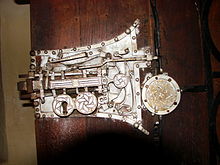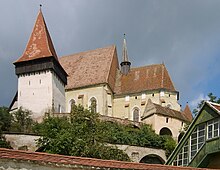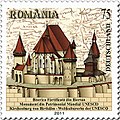Biertan
|
Biertan Biertan Berethalom |
||||
|
||||
| Basic data | ||||
|---|---|---|---|---|
| State : |
|
|||
| Historical region : | Transylvania | |||
| Circle : | Sibiu | |||
| Coordinates : | 46 ° 8 ' N , 24 ° 31' E | |||
| Time zone : | EET ( UTC +2) | |||
| Height : | 388 m | |||
| Area : | 97.26 km² | |||
| Residents : | 2,590 (October 20, 2011) | |||
| Population density : | 27 inhabitants per km² | |||
| Postal code : | 557045 | |||
| Telephone code : | (+40) 02 69 | |||
| License plate : | SB | |||
| Structure and administration (as of 2016) | ||||
| Community type : | local community | |||
| Structure : | Biertan, Copşa Mare , Richiş | |||
| Mayor : | Mircea-Mihai Dragomir ( PNL ) | |||
| Postal address : | Str. 1 Decembrie, no. 19 loc. Biertan, jud. Sibiu, RO-557045 |
|||
| Website : | ||||
Biertan ( German Birthälm , Hungarian Berethalom ) is a municipality in the Sibiu district in Transylvania , Romania .
geography
The place Biertan is located on the former Königsboden in a side valley of the Târnava Mare ( Great Kokel ), about 8 km south of the Kokel valley on the road that comes from Șaroș pe Târnave ( Sharosch ) to Richiș ( Reichesdorf ) and on to the Schlattner Hill Direction Agnita ( Agnetheln ) leads. The distance to the district town of Sibiu ( Hermannstadt ) is about 80 km in a south-westerly direction. The next two larger centers are Mediaș ( Mediasch ) and Sighișoara ( Schäßburg ).
The municipality of Biertan consists of the villages of Biertan, Richiș ( Reichesdorf ) and Copșa Mare ( Groß-Kopisch ) and has about 2500 inhabitants.
history
The first documentary mention comes from the year 1283, together with the places Hetzeldorf , Reichesdorf, Meschen , Mediasch, Pretai , Scharosch and Groß-Kopisch. The document is about a settlement of taxes to the Bishop of Transylvania, which is being negotiated (change from taxes in kind to a contribution of 40 silver marks ). This “haggling” makes it clear that Biertan was not yet subject to the law of the Golden Charter of 1224, in which such things were already adequately regulated. It must have been founded between 1224 and 1283.
Biertan was a village in the area of the two chairs of Mediasch and Schelk . This region obtained the rights of the Golden Charter from around 1315. In 1397 Biertan received the status of a market town (oppidum) . In 1418 King Sigismund of Luxembourg (1368–1437) granted market rights and high jurisdiction . After Nikolaus Apafi von Malmkrog renounced the office of hereditary count in 1440, the place was able to administer itself. In 1468, King Matthias Corvinus (1443–1490) freed a third of the citizens fit for military service from military service in favor of the defense of the fortified church.
The settlement quickly developed into an important market town. At the beginning of the 16th century Biertan was on the verge of becoming a city. At that time there were four so-called “pay houses” (which served as a tax assessment standard). The economic basis was a flourishing handicraft (in several guilds) and viticulture ( see: Viticulture in Romania ). In 1510 Biertan already had 31 tax "brands", which suggests a population of around 5000 people. The spatial expansion was also considerably larger than it is today. Urban development had started at full speed. The first quarter of the 16th century also saw the “major construction activity” in Biertan. During this period, the current Gothic hall church was built on the site of an early Gothic basilica . From 1468 there is also evidence of a fortification on the church hill, although the main construction period falls at the beginning of the 16th century. The fortified church was given its present form at that time. In 1572 the seat of the Saxon bishops under Lucas Unglerus was even relocated from Sibiu to Biertan, where it remained for almost 300 years (until 1867).
During the Turkish wars , however, there were repeated attacks. Since the place had no city walls yet, it was exposed to arson, looting and kidnapping relatively defenseless. Epidemics also decimated the population, so that the population was permanently reduced to a fraction of its old population. Gradually the place - in competition with the nearby cities Medias and Schäßburg - slipped into secondary status.
In the 1930 census, Biertan had 2331 inhabitants, of which 1228 were Transylvanian Saxons . In 1992 only 180 Saxons lived in the community. Currently their number has fallen to around 70 people.
UNESCO World Heritage Site
Church castle: The fortified church was founded in 1993 to UNESCO - World Heritage declared. It rises on a steep hill in the middle of the village. The inner, oldest wall ring of the castle is dated to the end of the 14th or beginning of the 15th century. As the seat of the Evangelical Bishop of Transylvania, the sacred building played an important role and was lavishly furnished. The Gothic hall church (which has no tower) is surrounded by three circular walls, six towers with a pyramid roof (hour tower, bell tower, mausoleum tower, Catholic tower, speck tower, entrance tower), two towers with a pent roof (town hall tower, weaver tower) and a bastion (divorce house or Marriage prison).
Today the Biertan fortified church is a major tourist attraction and its silhouette is known worldwide. Every year (with exceptions, e.g. 2007) it is the scene of the so-called “Sachsentreffen” of the Transylvanian Saxons who remained in Transylvania .
Works of art and building parts of the fortified church of particular historical value:
- Bishop's crypt (mausoleum tower): The mausoleum tower is located in the inner wall ring, northeast of the church. Since the old cemetery behind the German School was abandoned, the bishops' bones were exhumed in 1913 and buried in a crypt in the middle of this tower. On the walls are nine grave slabs, seven of them in memory of the following bishops: Franz Graffius , Georg Theilesius , Christian Barth , Christian Haas , Lucas Unglerus , Zacharias Weyrauch and Mathias Schiffbaumer . The other two tombstones are dedicated to Franz Salicaeus (pastor and general dean ) and Pleban Johannes (builder of the church). It is noticeable that all figures have their noses chopped off. According to a legend, the Turks are said to have cut off the noses of the bishops when they penetrated into the inner courtyard during a siege.
- Catholic tower: This tower, also in the inner ring wall, south of the church, has a chapel-like room with a barrel vault on the ground floor (round barrel). The walls are still completely frescoed. The name comes from the fact that the Catholic masses were held in the tower in the predominantly Protestant place.
- Shed tower (town hall tower): In the second (middle) circular wall there is a tower with a shed roof on the west side, on the facade of which there are frescoes from the 16th century. The driveway to the inner courtyard of the castle runs through this tower, as well as through three other towers (entrance tower, Speckturm and Stundenturm). This makes it one of the four gate towers that used to block the entrance to the castle with drop gates in the event of war.
- Portals: The three portals of the church have been preserved in their original medieval state. Both the sandstone tracery and the doors themselves date from the 16th century. The lock of the north portal is a so-called conundrum .
- Guild flags: Since Biertan was a market town with a large number of craftsmen who organized themselves into guilds, there were certain guild badges - the so-called guild flags. Several of these have been preserved in the church.
- Pulpit: The pulpit is in the church, outside the choir. It is made from a single large block of sandstone and shows filigree stone carvings, some of which are from the late Gothic and some from the Renaissance. It was created in 1523 or 1524.
- Winged altar: Inside the church there is one of the largest medieval winged altars in Transylvania with 28 pre-Reformation panels, which - unusually - show the festival side (the unfolded panels) every day and are only closed on the high holidays (Christmas, Easter and Pentecost).
- Stalls: In the chancel opposite the sacristy door are the old episcopal choir stalls. It comes from the Schäßburg woodcarver Johannes Reychmuth , from whom other valuable works have been preserved in Reichesdorf and Schäßburg. It is made of linden wood and decorated with intricate inlays.
- Sacristy door: The sacristy door from 1515 is one of the greatest treasures of the fortified church. It is equipped with a sophisticated mechanism that includes a total of 19 latches and an automatic lock. Like the chairs, the door is also richly decorated with wood inlays and the lock on the inside (sacristy side) is framed with finely crafted hippopotamus heads and intricately chased. The door was exhibited at the World Exhibition in Paris in 1889 and attracted attention there.
- Divorce house: The so-called divorce house is located in the innermost wall ring, southeast of the church, about halfway between the mausoleum tower and the Catholic tower . Couples willing to divorce were locked up here - with only a bed, a table, a chair, a plate, a cup, a spoon, etc. They were kept there until they wanted to refrain from separating again. In the 400 years that the divorce house has been in use, there is said to have been only one divorce.
Personalities
- Lucas Unglerus (16th century), evangelical pastor and bishop, moved the bishopric to Biertan
- Andreas Heldmann (1688–1770), Germanist and historian, born in Birthälm
- Johann Peter Migendt (1703–1767), organ builder, born in Birthälm
- Friedrich Franz Salzer (1827–1890), surgeon and university professor in Vienna, born in Birthälm
- Georg Meyndt (1852–1903), song writer
- Hermann Phleps (1877–1964) architect, art historian and university professor.
- Artur Phleps (1881–1944), officer and corps commander with the rank of SS-Obergruppenführer
See also
literature
- Arne Franke: The defensive Sachsenland. Fortified churches in southern Transylvania. With a historical introduction by Harald Roth. German Cultural Forum for Eastern Europe, Potsdam 2007, ISBN 978-3-936168-27-3 .
- Johann Michael Salzer: The royal. Biertan free market in Transylvania. A contribution to the history of the Transylvanian Saxons. Graeser, Vienna 1881.
Web links
- Official website of the Heimatortsgemeinschaft (HOG) Birthälm eV
- Biertan on the website of the Association of Transylvanian Saxons
- Web presentation of Biertan in German, English, French, Dutch and Romanian
- General information about the fortified church
- Juliana Fabritius-Dancu: Detailed information about the fortified church at karpatenwilli.com
- Birthälm (Biertan) at capper-online.de
- Video of Biertan recorded in June 2007 4.39 'on YouTube
Individual evidence
- ↑ 2011 census in Romania at citypopulation.de
- ^ Entry "Birthälm / Biertan in the online encyclopedia on the culture and history of Germans in Eastern Europe" , accessed October 22, 2017
- ↑ Information on Lucas Unglerus ( Ungler (unequal) Lukács ) at oszk.hu (Hungarian)























